-
Countries
-
Data and Analysis
-
Special Focus
-
Crisis Responses
Contact
iomyemendtm@iom.int
Location
Yemen
Activity
- Flow Monitoring
Period Covered
Aug 01 2022 -Aug 31 2022
In August 2022, IOM Yemen DTM recorded 6,542 migrants entering Yemen, representing a 106% increase compared to July 2022 (3,171 ). In both Shabwah and Lahj DTM has registered an increase in arrivals compared to the last months. The overall increase is in part linked to decreased security measures by Djibouti coast guards and the good condition of the weather and the sea.
Due to the deteriorating humanitarian crisis in Yemen and the challenges in moving towards KSA, many migrants opted to return to the Horn of Africa. DTM teams in Djibouti recorded that during August 2022, a total of 266 migrants took the risky return by boat from Yemen to travel home. Moreover, DTM recorded 5,522 Yemeni returns from KSA during the month of August 2022, compared to 4,476 in July 2022.
Between 1 January and 31 August 2022, DTM recorded 40,979 migrants and 45,283 Yemeni migrant returnees to Yemen.
The migrant caseload was around 92 per cent Ethiopian nationals, and around eight per cent Somali nationals. The migrants are predominantly male (67%), with (22%) women, six per cent boys and five per cent girls also among the travelers.
Through August’s reporting period, 3,304 migrants arrived from Somalia and were recorded at Ber Ali flow monitoring point in Shabwah governorate. In Lahj governorate, 3,238 migrants arrived from Djibouti, where 1,723 were recorded at Al Makhabbah flow monitoring point (FMP), 902 at Al Cawhah FMP, 405 at Al Azaf FMP, 100 at Al-Hejaf FMP, 60 at Al-Hajeimah, and 48 at Hasy Eisa FMP.
Population Groups
Survey Methodology
Unit of Analysis Or Observation
Type of Survey or Assessment
Keywords
Geographical Scope
Administrative boundaries with available data
The current dataset covers the following administrative boundaries
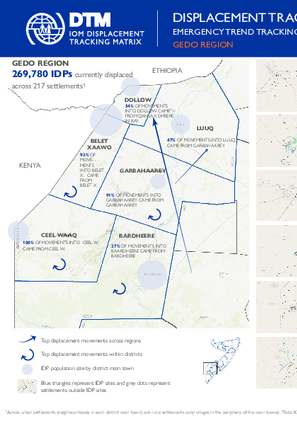
Contact
DTM Somalia, IOMSomaliaDTM@iom.int
Language
English
Location
Somalia
Period Covered
Aug 20 2022
Aug 24 2022
Activity
- Mobility Tracking
- Event Tracking
Since November 2021, 269,780 individuals have been displaced by drought in Gedo region. Since round 24, an estimated 7,625 IDPs arrived at the assessed settlements.
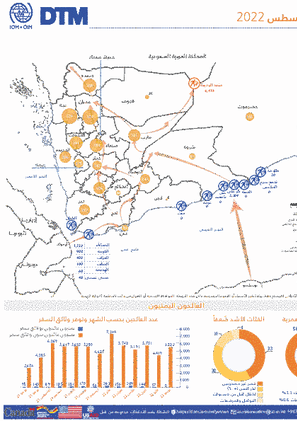
Contact
DTM Yemen, iomyemendtm@iom.int
Language
Arabic
Location
Yemen
Period Covered
Aug 01 2022
Aug 31 2022
Activity
- Flow Monitoring
في اغسطس 2022 ، سجلت مصفوفة تتبع النزوح (DTM) التابعة للمنظمة الدولية للهجرة في اليمن 6,542 مهاجرًا دخلوا اليمن ،بزيادة تمثل حوالي (%106) مقارنة بـ 3,171 مهاجرًا في يوليو 2022. في كل من شبوة ولحج ، سجلت مصفوفة تتبع النزوح زيادة في عدد الوافدين مقارنة بالاشهر الماضية. وترتبط الزيادة الإجماليه في جزء منها الى التحسن باحوال الطقس والبحر وتراجع زيادة الدوريات الحدودية في الجانب الجيبوتي.
سبب الأزمة الإنسانية المتدهورة في اليمن والتحديات في المضي قدمًا نحو المملكة العربية السعودية ، اختار العديد من المهاجرين العودة إلى القرن الأفريقي. حيث سجلت فرق مصفوفة تتبع النزوح في جيبوتي خلال اغسطس 2022 ، خوض 266 مهاجراً رحلة العودة الخطرة على متن قوارب من اليمن. بالإضافة إلى ذلك ، سجلت مصفوفة تتبع النزوح في اليمن حوالي 5,522 يمني عادوا من المملكة العربية السعودية خلال شهر اغسطس، مقارنة بـ 4,476 في يوليو 2022. خلال الفترة بين 1 يناير و 31 اغسطس 2022، وصل ما يقدر بـ 40,979 مهاجرًا و 45,283 يمنيًا عائداً إلى اليمن.
حيث مثل عدد المهاجرين من إثيوبيا92 % في المائة و في المائة من الصوماليين. كانت غالبية المهاجرين من الذكور (67%) مع (22%) من النساء ، و ستة في المائة من الأولاد وخمسة في المائة من الفتيات اللواتي كنا ايضاً من ضمن المسافرين.
خلال فترة التقرير في اغسطس 2022، شوهد وصول 3,304 مهاجرا من الصومال وتم تسجيلهم في نقطة مراقبة التدفق في بئر علي في محافظة شبوة. بينما شهدت نقاط مراقبة التدفق بمديرية المضاربة والعارة بمحافظة لحج وصول عدد 3,238 مهاجرا وصلوا من جيبوتي , حيث تم تسجيل 1,723 في المخابأه ؛ وا 902 في الكوحه ؛ وا 405 في العزاف ؛ وا 100 في الحجاف ؛ وا 60 في الهجيمه ؛ وا 48 في حسي عيسى.
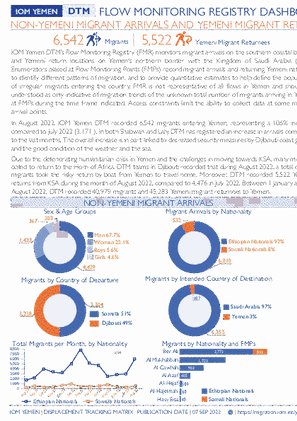
Contact
DTM Yemen, iomyemendtm@iom.int
Language
English
Location
Yemen
Period Covered
Aug 01 2022
Aug 31 2022
Activity
- Flow Monitoring
In August 2022, IOM Yemen DTM recorded 6,542 migrants entering Yemen, representing a 106% increase compared to July 2022 (3,171 ). In both Shabwah and Lahj DTM has registered an increase in arrivals compared to the last months. The overall increase is in part linked to decreased security measures by Djibouti coast guards and the good condition of the weather and the sea.
Due to the deteriorating humanitarian crisis in Yemen and the challenges in moving towards KSA, many migrants opted to return to the Horn of Africa. DTM teams in Djibouti recorded that during August 2022, a total of 266 migrants took the risky return by boat from Yemen to travel home. Moreover, DTM recorded 5,522 Yemeni returns from KSA during the month of August 2022, compared to 4,476 in July 2022. Between 1 January and 31 August 2022, DTM recorded 40,979 migrants and 45,283 Yemeni migrant returnees to Yemen.
The migrant caseload was around 92 per cent Ethiopian nationals, and around eight per cent Somali nationals. The migrants are predominantly male (67%), with (22%) women, six per cent boys and five per cent girls also among the travelers.
Through August’s reporting period, 3,304 migrants arrived from Somalia and were recorded at Ber Ali flow monitoring point in Shabwah governorate. In Lahj governorate, 3,238 migrants arrived from Djibouti, where 1,723 were recorded at Al Makhabbah flow monitoring point (FMP), 902 at Al Cawhah FMP, 405 at Al Azaf FMP, 100 at Al-Hejaf FMP, 60 at Al-Hajeimah, and 48 at Hasy Eisa FMP.
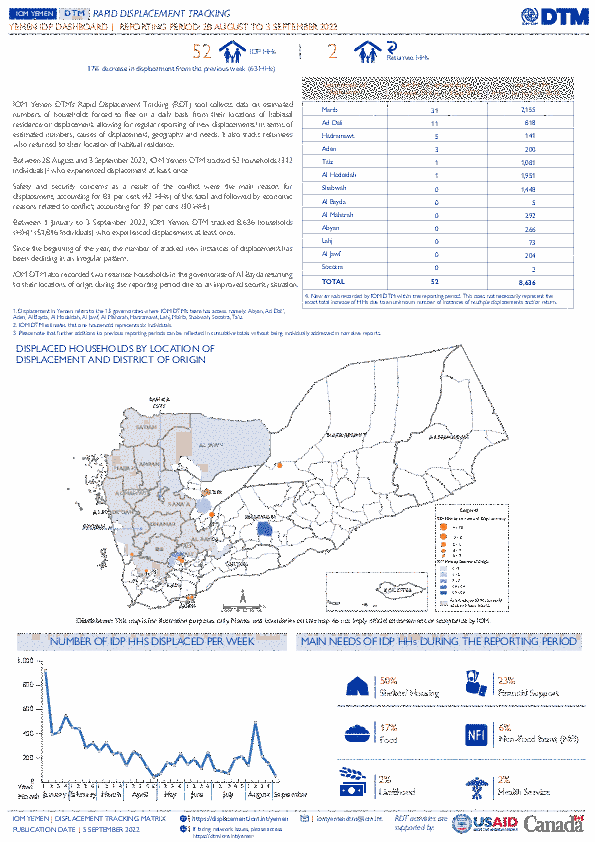
Contact
DTM Yemen, iomyemendtm@iom.int
Language
English
Location
Yemen
Period Covered
Aug 28 2022
Sep 03 2022
Activity
- Mobility Tracking
IOM Yemen DTM’s Rapid Displacement Tracking (RDT) tool collects data on estimated numbers of households forced to flee on a daily basis from their locations of origin or displacement, allowing for regular reporting of new displacements in terms of estimated numbers, geography, and needs. It also tracks returnees who returned to their location of origin.
From 1 January to 3 September 2022, IOM Yemen DTM tracked 8,636 households (HH) (51,816 Individuals) who experienced displacement at least once.
Between 28 August and 3 September 2022, IOM Yemen DTM tracked 52 households (312 individuals) displaced at least once. The majority of people moved into/within the following governorates and districts:
- Marib (31 HHs) – Marib City (19 HHs), Harib (6 HHs), Marib (6 HHs) districts. Most displacements in the governorate originated from Shabwah and Marib.
- Ad Dali (11 HHs) – Ad Dali (9 HHs), Qatabah (2 HHs) districts. All displacements in the governorate were internal.
- Hadramawt (5 HHs) – Al Abr (5 HHs) district. All displacements in the governorate originated from Marib.
The majority of people moved from the following governorates and districts:
- Shabwah (14 HHs) – Ataq (14 HHs) district.
- Ad Dali (11 HHs) – Qatabah (7 HHs), Al Husha (4 HHs) districts.
- Marib (11 HHs) – Jabal Murad (6 HHs), Al Jubah (5 HHs) districts.
IOM identified 88 households displaced in the previous reporting period, which covered 21 August - 27 August 2022, in the governorates of Marib (52 HHs), Hadramawt (21 HHs), Al Hodeidah (7 HHs), Aden (5 HHs), Socotra (2 HHs), and Taiz (1 HHs). These figures have been added to the cumulative displacement total recorded since the beginning of the year.
Methods used:
· DTM’s Rapid Displacement Tracking (RDT) tool collects and reports on numbers of households forced to flee on a daily basis, allowing for regular reporting of new displacements in terms of numbers, geography and needs.
Limitations:
· DTM Yemen is unable to report on figures in some governorates due to access limitations.
Let us know if you need any further information regarding displacement in Yemen.
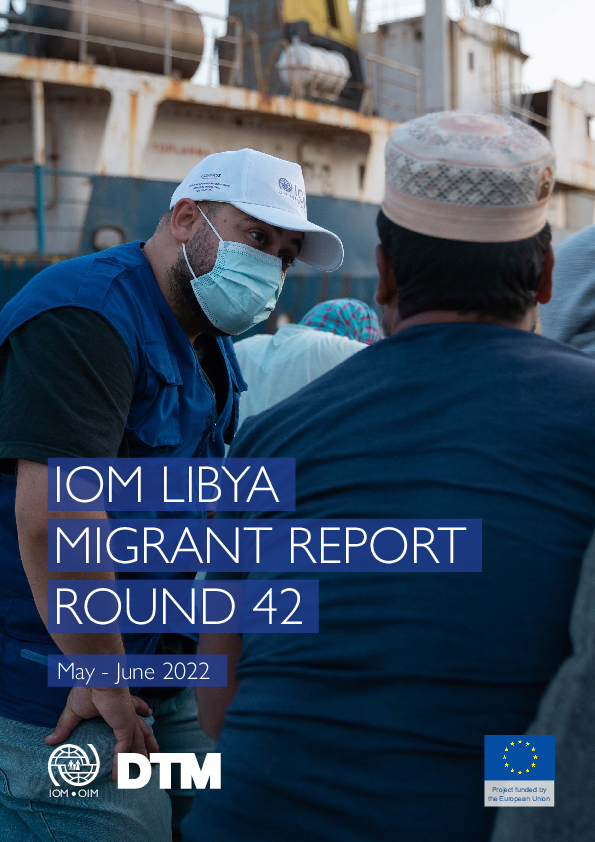
Contact
DTM Libya, DTMLibya@iom.int
Language
English
Location
Libya
Period Covered
May 01 2022
Jun 30 2022
Activity
- Mobility Tracking
- Baseline Assessment
IOM Libya’s Displacement Tracking Matrix (DTM) programme identified a total of 667,440 migrants from over 41 nationalities in the 100 Libyan municipalities during Round 42 of data collection (May - June 2022).Data collected by DTM Libya continues to show an increase in the number of migrants in Libya compared to the previous reporting period (649,788 migrants, Round 41, April 2022) in line with a trend that started at the beginning of 2021. This increase also corresponds with the arrival of seasonal migrant workers in Libya (generally between March and May). The number of migrants in Libya identified during Round 42 is higher than for the corresponding period in 2021 (597,611 migrants, Round 37, June 2021) and slightly above that of 2019 (655,144 migrants, Round 26, July 2019).

Contact
DTM Libya, DTMLibya@iom.int
Language
English
Location
Libya
Period Covered
May 01 2022
Jun 30 2022
Activity
- Flow Monitoring
- Mobility Tracking
- Baseline Assessment
This infographic presents the key findings of Round 42 of the mobility tracking component of the Displacement Tracking Matrix (DTM) programme in Libya.
Contact
dtmlibya@iom.int
Location
Libya
Activity
- Mobility Tracking
- Baseline Assessment
Period Covered
May 01 2022 -Jun 30 2022
A baseline assessment is a sub-component of mobility tracking. It aims to collect data on IDP, migrant or returnee population presence in a defined administrative area of the country.
Population Groups
Survey Methodology
Unit of Analysis Or Observation
Type of Survey or Assessment
Keywords
Geographical Scope
Administrative boundaries with available data
The current dataset covers the following administrative boundaries
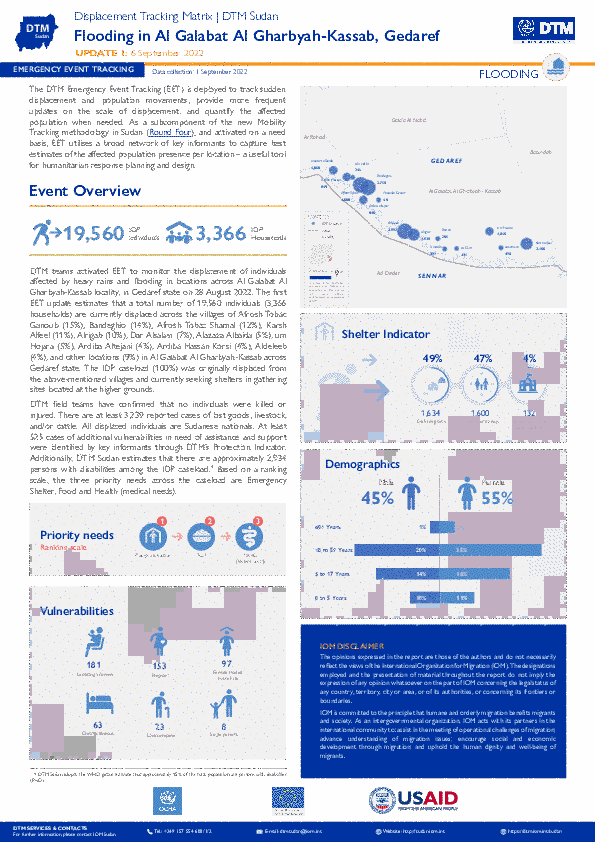
Contact
DTM Sudan; dtmsudan@iom.int
Language
English
Location
Sudan
Snapshot Date
Sep 01 2022
Activity
- Mobility Tracking
- Event Tracking
The DTM Emergency Event Tracking (EET) is deployed to track sudden displacement and population movements, provide more frequent updates on the scale of displacement, and quantify the affected population when needed. As a subcomponent of the new Mobility Tracking methodology in Sudan (Round Four), and activated on a need basis, EET utilises a broad network of key informants to capture best estimates of the affected population presence per location – a useful tool for humanitarian response planning and design.

Contact
DTM Sudan; dtmsudan@iom.int
Language
English
Location
Sudan
Snapshot Date
Aug 31 2022
Activity
- Mobility Tracking
- Event Tracking
The DTM Emergency Event Tracking (EET) is deployed to track sudden displacement and population movements, provide more frequent updates on the scale of displacement, and quantify the affected population when needed. As a subcomponent of the new Mobility Tracking methodology in Sudan (Round Four), and activated on a need basis, EET utilises a broad network of key informants to capture best estimates of the affected population presence per location – a useful tool for humanitarian response planning and design.
